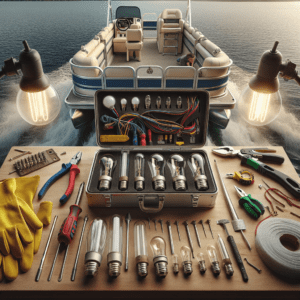Navigation Lights on Pontoon Boats
Pontoon boats are a popular choice for recreational boating, providing comfort and stability on the water. However, proper lighting is critical for safe piloting. Navigation lights serve the dual purpose of complying with legal requirements and ensuring the safety of all on board, especially during night-time or low-visibility conditions.
A. Legal and Safety Requirements for Navigation Lights
Navigation lights are required by law to be displayed after sunset and before sunrise, or during any period of reduced visibility. These lights must be visible from a distance of at least two nautical miles and be installed in accordance with the United States Coast Guard regulations. Failure to comply with these regulations could lead to accidents, fines, or even imprisonment.
B. Types of Navigation Lights and Their Purposes
Navigation lights come in different shapes, sizes, colors, and intensity levels – each serving a different purpose. The port light, or red light, indicates the boat’s left side. The starboard light, or green light, indicates the boat’s right side. The stern light, or white light, is mounted at the boat’s rear and is visible from all directions. Together, these three lights establish a safe navigational path.
C. Identifying When to Replace Navigation Lights
Navigation lights are subject to wear and tear and may be damaged during boating activities. Regular inspections are crucial to ensuring their proper function. Common signs of malfunctioning lights include dimness, flickering, or complete failure. Any such indications signal the need to repair or replace the lights immediately.
Preparing for the Replacement of Navigation Lights
A. Tools and Materials Needed for the Job
Before you start the replacement process, you’ll need to have the right tools and materials on-hand. Here’s a list of what you’ll need:
- Phillips head screwdriver
- Flathead screwdriver
- Needle nose pliers
- Wire cutters/strippers
- Butane torch or heat gun
- Marine sealant
- New navigation lights (make sure they are compatible with your pontoon boat)
- New wiring and connectors (if needed)
B. Selecting the Right Type of Replacement Lights
When selecting new navigation lights for your pontoon boat, there are a few things to consider. First, make sure the lights are compatible with your boat. Check the specifications and user manual to ensure you’re selecting the right size and type of lights. Additionally, consider the type of boating you’ll be doing – if you’ll be out on the water in inclement weather or at night, you may want to opt for brighter or more durable lights. Finally, consider your budget – while you don’t want to skimp on important safety equipment, there are a variety of price points available in the market.
C. Safety Precautions and Disconnecting Power Sources
Before beginning the replacement process, it’s important to take necessary precautions to ensure your safety. Turn off all power sources to the navigation light wires before removing any fixtures, and make sure any passengers on board are aware of the work being done. Additionally, be sure to take proper safety measures such as wearing gloves and eye protection.
To disconnect the power sources, locate the circuit breaker or fuse for your pontoon boat’s navigation lights and turn it off. If you’re unsure where the circuit breaker or fuse is located, consult your boat’s user manual or a professional for assistance.
Step-by-Step Guide to Removing Old Navigation Lights
A. Accessing and Loosening the Old Fixtures
When replacing navigation lights on your pontoon boat, you’ll first need to access and loosen the old fixtures. Locate the screws or bolts that hold the light in place and use a screwdriver or wrench to remove them. Be sure to keep track of these screws and bolts as you’ll need them later.
B. Handling Wiring and Connectors
Once you’ve removed the screws or bolts, gently pull the fixture away from the boat to expose the wiring and connectors. Take a photo of the wiring and connectors before removing any wires to ensure proper reinstallation later. Now, loosen the connectors and remove the wires from the old fixture.
C. Troubleshooting Common Issues During Removal
Removing navigation lights from a pontoon boat can be challenging due to corrosion, rust, and other factors. If the screws or bolts are stuck, try applying some lubricant to the threads and let it sit for a few minutes before trying again. If the wiring is difficult to remove, use wire cutters to snip the wires close to the fixture, and then strip the wire to expose fresh strands of wire.
Remember, when removing old navigation lights, be sure to handle them with care to avoid damaging the wires or connectors. It’s also important to dispose of the old fixtures properly according to your local regulations.
Installing New Navigation Lights on Your Pontoon Boat
Changing navigation lights on your pontoon boat can be a simple task that you can perform yourself. In this section, we will guide you through a step-by-step process of how to install new navigation lights on your pontoon boat.
A. Positioning and Securing New Light Fixtures
Before installing new navigation lights, you need to determine their location on the boat and ensure that they are visible from all angles. The United States Coast Guard mandates that navigation lights be placed in specific positions, so consult the regulations to ensure accuracy.
After choosing a location, use a marker or pencil to create an outline of your light fixture’s holes, ensuring that you will properly install them without any gaps.
To install the fixture, insert a sealing compound around it and then screw it to the boat. Moreover, apply some marine caulk around the edges of the fixture and ensure that it sits flush with your boat.
B. Connecting Wires and Ensuring Proper Polarity
Once the light fixture is securely installed, you need to connect wires to it and ensure that they are properly grounded to avoid electrical hazards.
Firstly, connect the wires that power the lights to the fixture. Depending on the model, you might need to strip the wires to connect them properly. Check the model’s wiring schematic to ensure a correct connection.
Further, ensure that the wires are properly insulated to reduce fire hazards, and connect the fixture’s ground wire to the boat’s grounding position.
C. Testing the Lights before Final Assembly
After making all the connections, temporarily attach the fixture to the boat, and turn on the lights to ensure that they are functioning as intended. Once you have verified that everything is working correctly, proceed to fasten the fixture permanently.
Before finishing the installation, ensure that all the wiring is out of the way and can’t be damaged by any potential impact, water, or moisture. In addition, recheck the light fixture’s position to ensure it is secure and flush against the boat.
In conclusion, installing new navigation lights on your pontoon boat is a fairly simple process, and it ensures your boat adheres to safety regulations, keeping you and your passengers safe on nighttime boating trips.
| Step | Description |
|---|---|
| A. | Positioning and Securing New Light Fixtures |
| • | Determine location and create outline |
| • | Insert sealing compound and screw to boat |
| • | Apply marine caulk and ensure fixture flush with boat |
| B. | Connecting Wires and Ensuring Proper Polarity |
| • | Connect wires to fixture |
| • | Ensure proper insulation and grounding |
| C. | Testing the Lights before Final Assembly |
| • | Turn on lights to test functionality |
| • | Permanently fasten fixture and recheck position |
Maintenance and Best Practices for Navigation Lights
Navigation lights are an essential safety feature of your pontoon boat, especially if you like to go boating at night or in low-light conditions. It is important to keep them in good working order to ensure the safety of your passengers and comply with legal requirements. Here are some best practices for maintenance, troubleshooting and repair to help you get the most out of your navigation lights:
A. Routine Inspection and Cleaning Tips
Regular inspections of your navigation lights are essential to ensure they are working properly. Check them before and after every trip and make it a part of your pre-departure checklist. Look for any physical damage, cracks or water intrusion as they can cause malfunction or corrosion over time. Be sure to clean them regularly with a soft cloth and mild detergent to avoid the buildup of dirt, grime and saltwater residue.
B. Troubleshooting and Repair Tips for Common Issues
If you are experiencing problems with your navigation lights, here are some common issues you may encounter and how to troubleshoot them:
- If the lights are not turning on, check the bulbs and wiring connections. Replace the bulbs if they are burned out or the connections if they are loose or corroded.
- If the lights are dim or flickering, it could be a sign of a weak battery or a bad grounding connection. Make sure your battery is fully charged and check the grounding connection for corrosion or damage.
- If the lights are too bright or too dim, it could be due to a voltage regulator issue. Test the voltage regulator to ensure it is working properly.
C. Recommendations for Longevity of Your Pontoon Boat’s Navigation Lights
Here are some recommendations to help you extend the life of your navigation lights and keep them working properly for years to come:
- Invest in high-quality lights that are specifically designed for boats and rated for exposure to water.
- Use sealed LED lights whenever possible as they consume less power, produce less heat and have a longer lifespan.
- Avoid using harsh chemical cleaners or abrasive materials that can scratch or damage the light fixtures.
- Store your boat under a covered area when not in use to prevent prolonged exposure to sunlight and to keep the lights dry.
Frequently Asked Questions
Q: Are navigation lights required for pontoon boats?
A: Yes, navigation lights are required for pontoon boats, especially when navigating in low-light conditions or at night. They are essential for safely identifying your vessel’s position and displaying its orientation to other vessels.
Q: Can I replace my navigation lights myself?
A: Yes, you can replace your navigation lights yourself as long as you have the necessary tools and follow the proper installation procedures. It is important to consult the manual for your specific light fixtures and to observe safety precautions when working with electrical wiring.
Q: How often should I inspect my navigation lights?
A: You should inspect your navigation lights before and after every trip to ensure they are in good working order. Regular inspections will help you identify any potential issues early and prevent costly repairs or replacements down the road.



















